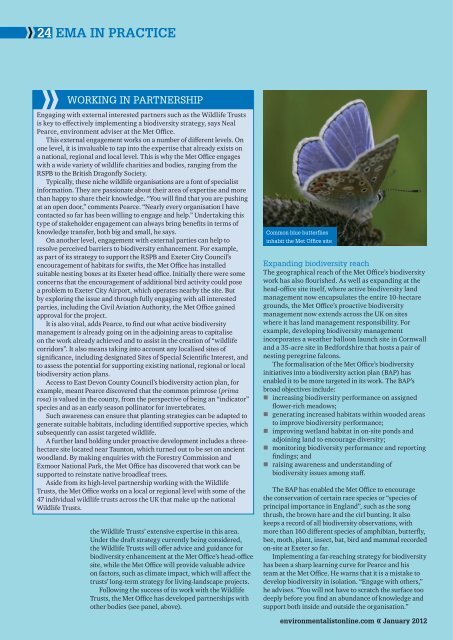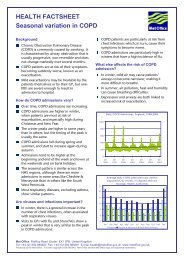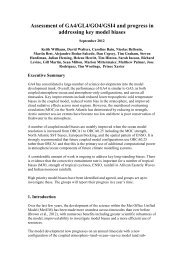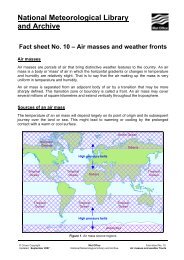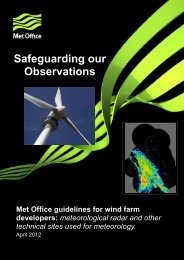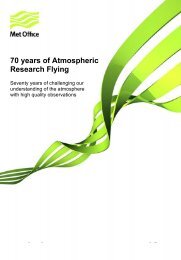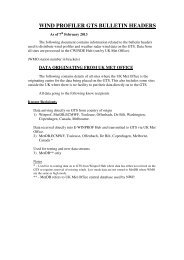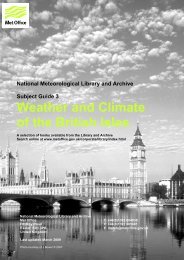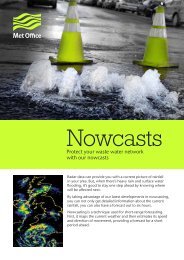Environmentalist article (PDF, 981 kB) - Met Office
Environmentalist article (PDF, 981 kB) - Met Office
Environmentalist article (PDF, 981 kB) - Met Office
- No tags were found...
Create successful ePaper yourself
Turn your PDF publications into a flip-book with our unique Google optimized e-Paper software.
24EMA IN PRACTICEWORKING IN PARTNERSHIPEngaging with external interested partners such as the Wildlife Trustsis key to effectively implementing a biodiversity strategy, says NealPearce, environment adviser at the <strong>Met</strong> <strong>Office</strong>.This external engagement works on a number of different levels. Onone level, it is invaluable to tap into the expertise that already exists ona national, regional and local level. This is why the <strong>Met</strong> <strong>Office</strong> engageswith a wide variety of wildlife charities and bodies, ranging from theRSPB to the British Dragonfly Society.Typically, these niche wildlife organisations are a font of specialistinformation. They are passionate about their area of expertise and morethan happy to share their knowledge. “You will find that you are pushingat an open door,” comments Pearce. “Nearly every organisation I havecontacted so far has been willing to engage and help.” Undertaking thistype of stakeholder engagement can always bring benefits in terms ofknowledge transfer, both big and small, he says.On another level, engagement with external parties can help toresolve perceived barriers to biodiversity enhancement. For example,as part of its strategy to support the RSPB and Exeter City Council’sencouragement of habitats for swifts, the <strong>Met</strong> <strong>Office</strong> has installedsuitable nesting boxes at its Exeter head office. Initially there were someconcerns that the encouragement of additional bird activity could posea problem to Exeter City Airport, which operates nearby the site. Butby exploring the issue and through fully engaging with all interestedparties, including the Civil Aviation Authority, the <strong>Met</strong> <strong>Office</strong> gainedapproval for the project.It is also vital, adds Pearce, to find out what active biodiversitymanagement is already going on in the adjoining areas to capitaliseon the work already achieved and to assist in the creation of “wildlifecorridors”. It also means taking into account any localised sites ofsignificance, including designated Sites of Special Scientific Interest, andto assess the potential for supporting existing national, regional or localbiodiversity action plans.Access to East Devon County Council’s biodiversity action plan, forexample, meant Pearce discovered that the common primrose (primarosa) is valued in the county, from the perspective of being an “indicator”species and as an early season pollinator for invertebrates.Such awareness can ensure that planting strategies can be adapted togenerate suitable habitats, including identified supportive species, whichsubsequently can assist targeted wildlife.A further land holding under proactive development includes a threehectaresite located near Taunton, which turned out to be set on ancientwoodland. By making enquiries with the Forestry Commission andExmoor National Park, the <strong>Met</strong> <strong>Office</strong> has discovered that work can besupported to reinstate native broadleaf trees.Aside from its high-level partnership working with the WildlifeTrusts, the <strong>Met</strong> <strong>Office</strong> works on a local or regional level with some of the47 individual wildlife trusts across the UK that make up the nationalWildlife Trusts.the Wildlife Trusts’ extensive expertise in this area.Under the draft strategy currently being considered,the Wildlife Trusts will offer advice and guidance forbiodiversity enhancement at the <strong>Met</strong> <strong>Office</strong>’s head-officesite, while the <strong>Met</strong> <strong>Office</strong> will provide valuable adviceon factors, such as climate impact, which will affect thetrusts’ long-term strategy for living-landscape projects.Following the success of its work with the WildlifeTrusts, the <strong>Met</strong> <strong>Office</strong> has developed partnerships withother bodies (see panel, above).Common blue butterfliesinhabit the <strong>Met</strong> <strong>Office</strong> siteExpanding biodiversity reachThe geographical reach of the <strong>Met</strong> <strong>Office</strong>’s biodiversitywork has also flourished. As well as expanding at thehead-office site itself, where active biodiversity landmanagement now encapsulates the entire 10-hectaregrounds, the <strong>Met</strong> <strong>Office</strong>’s proactive biodiversitymanagement now extends across the UK on siteswhere it has land management responsibility. Forexample, developing biodiversity managementincorporates a weather balloon launch site in Cornwalland a 35-acre site in Bedfordshire that hosts a pair ofnesting peregrine falcons.The formalisation of the <strong>Met</strong> <strong>Office</strong>’s biodiversityinitiatives into a biodiversity action plan (BAP) hasenabled it to be more targeted in its work. The BAP’sbroad objectives include:• increasing biodiversity performance on assignedflower-rich meadows;• generating increased habitats within wooded areasto improve biodiversity performance;• improving wetland habitat in on-site ponds andadjoining land to encourage diversity;• monitoring biodiversity performance and reportingfindings; and• raising awareness and understanding ofbiodiversity issues among staff.The BAP has enabled the <strong>Met</strong> <strong>Office</strong> to encouragethe conservation of certain rare species or “species ofprincipal importance in England”, such as the songthrush, the brown hare and the cirl bunting. It alsokeeps a record of all biodiversity observations, withmore than 160 different species of amphibian, butterfly,bee, moth, plant, insect, bat, bird and mammal recordedon-site at Exeter so far.Implementing a far-reaching strategy for biodiversityhas been a sharp learning curve for Pearce and histeam at the <strong>Met</strong> <strong>Office</strong>. He warns that it is a mistake todevelop biodiversity in isolation. “Engage with others,”he advises. “You will not have to scratch the surface toodeeply before you find an abundance of knowledge andsupport both inside and outside the organisation.”environmentalistonline.com « January 2012


